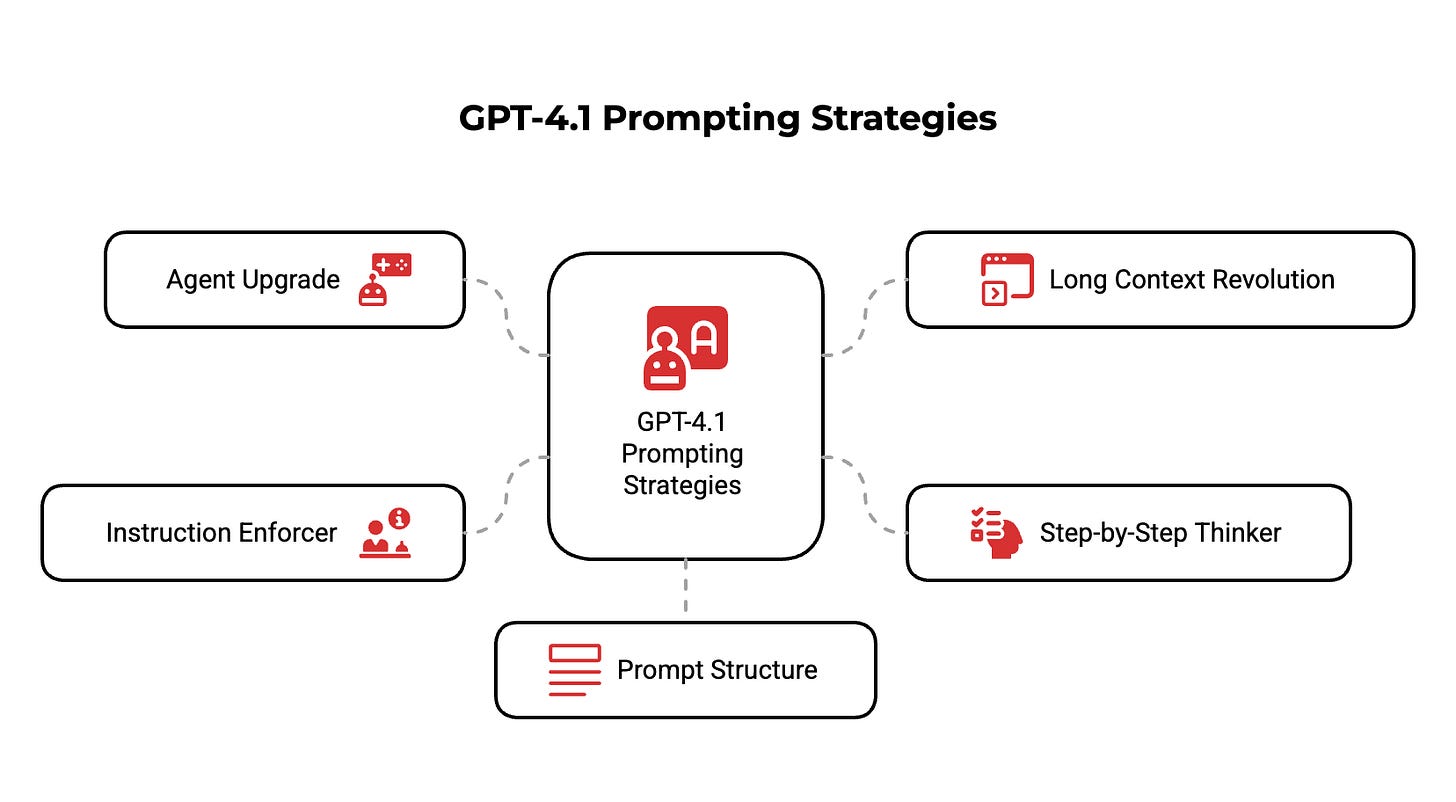OpenAI's GPT-4.1 Prompting Guide Explained
How to transform AI from corporate novelty to tactical advantage—but only if you ditch your old habits
Hey Adopter,
OpenAI released their GPT-4.1 prompting guide yesterday with zero fanfare. After spending six hours dissecting it, I can tell you this is the manual we've needed all along. While most teams are still fumbling with vague prompts and crossed fingers, this guide reveals how the latest model actually works and what it finally gets right.
IMPORTANT CLARIFICATION: Looking for GPT-4.1 in your ChatGPT Plus account? You won't find it there. GPT-4.1 is currently available only through the OpenAI API for developers and businesses, not directly in the ChatGPT interface. As a Plus subscriber, your most advanced model remains GPT-4o. To access GPT-4.1, you'll need a developer account with separate usage billing. This separation of consumer and developer models explains the confusing naming conventions you might have noticed. The techniques in this newsletter still apply to your GPT work, but the full power of these prompting strategies shines brightest with API access to GPT-4.1.
Why This Guide Matters to Your Career
If you've been frustrated with AI's hit-or-miss outputs, GPT-4.1 represents a significant shift. The model now follows instructions more literally and precisely than its predecessors. This means all those prompts you've carefully crafted? They might actually need a complete overhaul.
The stark reality is that most teams paste half-baked questions into ChatGPT and wonder why the output looks like office small-talk in code form. OpenAI finally admits what we've been saying: the model is not the bottleneck – your inputs are.
Five Key Changes That Will Impact Your Work Tomorrow
1. The Agent Upgrade
GPT-4.1 is dramatically better at what OpenAI calls "agentic workflows" – essentially, letting the AI drive complex tasks forward on its own. Their internal testing shows it solving 55% of SWE-bench coding problems when properly prompted, which is revolutionary for non-reasoning models.
The game-changer here is how you structure your prompts. OpenAI recommends three key components:
Persistence: "Keep going until the query is completely resolved."
Tool-calling: "Use your tools to gather information, don't guess."
Planning: "Plan before each action and reflect on previous actions."
These simple instructions transformed their test model from a passive chatbot into what they call a "much more 'eager' agent" – one that drives interaction forward independently.
2. The Long Context Revolution
GPT-4.1 has a massive 1M token input context window that actually works. Previous models claimed long context but fell apart when retrieving information from the far reaches of your documents.
But placement matters more than ever. The guide recommends bracketing your instructions at both the beginning AND end of provided context. When that's not possible, instructions above your context work better than below.
3. The Step-by-Step Thinker
While GPT-4.1 isn't technically a "reasoning model," you can dramatically improve its performance by asking it to think step by step. OpenAI's internal tests showed a 4% improvement on complex tasks just by adding this simple prompt:
First, think carefully step by step about what documents are needed to answer the query.This is essentially getting the model to "think out loud" – breaking complex problems into manageable chunks before tackling them.
4. The Instruction Enforcer
Previous models tried to guess what you meant. GPT-4.1 takes your instructions at face value, which means you need to be crystal clear. No more relying on the model to infer what you want.
The guide suggests a prompt development workflow:
Start with clear, high-level guidance in bullet points
Add specific sections for behaviors you want to change
Use ordered lists for step-by-step instructions
If things still aren't working, check for conflicting instructions
5. The Prompt Structure That Actually Works
OpenAI finally released their recommended prompt template. This isn't just academic – it's what they use internally:
# Role and Objective
# Instructions
## Sub-categories for more detailed instructions
# Reasoning Steps
# Output Format
# Examples
## Example 1
# Context
# Final instructions and prompt to think step by step
What This Means For Your Monday Morning
That vague request you paste into ChatGPT? It's the equivalent of briefing an intern with a shrug. The difference between "Can you just summarize this?" and a properly structured prompt could mean hours of rework.
Most teams waste up to five hours weekly rewriting sloppy AI drafts that could have been right the first time. The practical impact here is not trivial – it's the difference between AI as a curiosity and AI as a genuine productivity lever.
The Challenge Ahead
The tradeoff is clear: GPT-4.1 follows instructions more literally, requiring you to be more precise. Your existing prompts likely won't work as well because they relied on the model's ability to infer what you wanted.
This is where our mini-course concept – The 4-P Prompt OS – aligns perfectly with OpenAI's new guidance. The course teaches:
Plan: Define role, goal, and constraints before generating a single token
Prompt: Deliver minimalist, layered instructions that steer without strait-jacketing
Parse: Measure the reply against acceptance criteria
Polish: Refine tone, then file the prompt-output pair in a searchable vault
Sound familiar? That's because many of the techniques in our Prompt Power Playbook have now been validated by OpenAI's own research.
Next Steps For You
Review your current prompt templates against the new structure
Test adding persistence, tool-calling, and planning instructions
Try bracketing long documents with instructions at both ends
Break complex tasks into step-by-step thinking prompts
If you're serious about leveraging GPT-4.1 for real workplace advantage, stop treating it like an intern with vague assignments. Treat it like legal counsel – with precise, structured briefs that leave nothing to chance.
In a world where everyone has access to the same AI tools, competitive advantage doesn't come from having access to GPT-4.1. It comes from knowing how to use it better than your peers.
Adapt & Create,
Kamil






